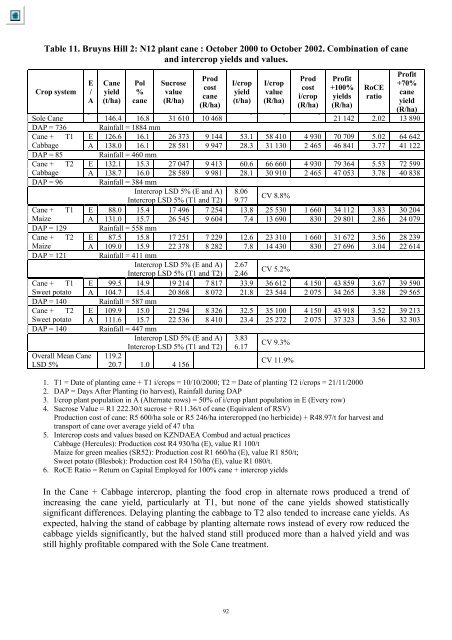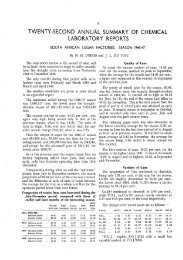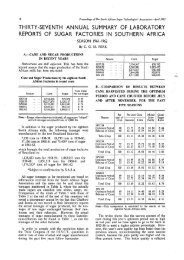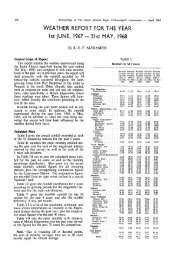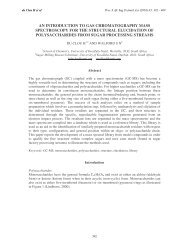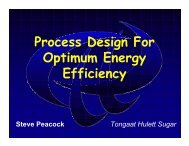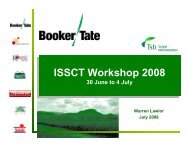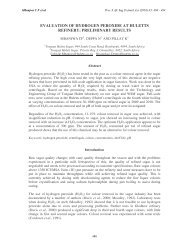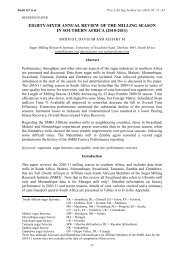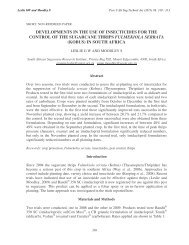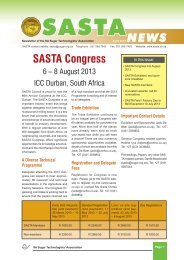Successful Intercropping of Sugarcane - sasta
Successful Intercropping of Sugarcane - sasta
Successful Intercropping of Sugarcane - sasta
You also want an ePaper? Increase the reach of your titles
YUMPU automatically turns print PDFs into web optimized ePapers that Google loves.
Table 11. Bruyns Hill 2: N12 plant cane : October 2000 to October 2002. Combination <strong>of</strong> cane<br />
and intercrop yields and values.<br />
<br />
Crop system<br />
Pr<strong>of</strong>it<br />
Prod<br />
Prod Pr<strong>of</strong>it<br />
E Cane Pol Sucrose<br />
I/crop I/crop<br />
+70%<br />
cost<br />
cost +100% RoCE<br />
/ yield % value<br />
yield value<br />
cane<br />
cane<br />
i/crop yields ratio<br />
A (t/ha) cane (R/ha)<br />
(t/ha) (R/ha)<br />
yield<br />
(R/ha)<br />
(R/ha) (R/ha)<br />
(R/ha)<br />
Sole Cane 146.4 16.8 31 610 10 468 21 142 2.02 13 890<br />
DAP = 736 Rainfall = 1884 mm<br />
Cane + T1 E 126.6 16.1 26 373 9 144 53.1 58 410 4 930 70 709 5.02 64 642<br />
Cabbage A 138.0 16.1 28 581 9 947 28.3 31 130 2 465 46 841 3.77 41 122<br />
DAP = 85 Rainfall = 460 mm<br />
Cane + T2 E 132.1 15.3 27 047 9 413 60.6 66 660 4 930 79 364 5.53 72 599<br />
Cabbage A 138.7 16.0 28 589 9 981 28.1 30 910 2 465 47 053 3.78 40 838<br />
DAP = 96 Rainfall = 384 mm<br />
Intercrop LSD 5% (E and A) 8.06<br />
Intercrop LSD 5% (T1 and T2) 9.77<br />
CV 8.8%<br />
Cane + T1 E 88.0 15.4 17 496 7 254 13.8 25 530 1 660 34 112 3.83 30 204<br />
Maize A 131.0 15.7 26 545 9 604 7.4 13 690 830 29 801 2.86 24 079<br />
DAP = 129 Rainfall = 558 mm<br />
Cane + T2 E 87.5 15.8 17 251 7 229 12.6 23 310 1 660 31 672 3.56 28 239<br />
Maize A 109.0 15.9 22 378 8 282 7.8 14 430 830 27 696 3.04 22 614<br />
DAP = 121 Rainfall = 411 mm<br />
Intercrop LSD 5% (E and A) 2.67<br />
Intercrop LSD 5% (T1 and T2) 2.46<br />
CV 5.2%<br />
Cane + T1 E 99.5 14.9 19 214 7 817 33.9 36 612 4 150 43 859 3.67 39 590<br />
Sweet potato A 104.7 15.4 20 868 8 072 21.8 23 544 2 075 34 265 3.38 29 565<br />
DAP = 140 Rainfall = 587 mm<br />
Cane + T2 E 109.9 15.0 21 294 8 326 32.5 35 100 4 150 43 918 3.52 39 213<br />
Sweet potato A 111.6 15.7 22 536 8 410 23.4 25 272 2 075 37 323 3.56 32 303<br />
DAP = 140 Rainfall = 447 mm<br />
Intercrop LSD 5% (E and A) 3.83<br />
Intercrop LSD 5% (T1 and T2) 6.17<br />
CV 9.3%<br />
Overall Mean Cane<br />
LSD 5%<br />
119.2<br />
20.7 1.0 4 156<br />
CV 11.9%<br />
1. T1 = Date <strong>of</strong> planting cane + T1 i/crops = 10/10/2000; T2 = Date <strong>of</strong> planting T2 i/crops = 21/11/2000<br />
2. DAP = Days After Planting (to harvest), Rainfall during DAP<br />
3. I/crop plant population in A (Alternate rows) = 50% <strong>of</strong> i/crop plant population in E (Every row)<br />
4. Sucrose Value = R1 222.30/t sucrose + R11.36/t <strong>of</strong> cane (Equivalent <strong>of</strong> RSV)<br />
Production cost <strong>of</strong> cane: R5 600/ha sole or R5 246/ha intercropped (no herbicide) + R48.97/t for harvest and<br />
transport <strong>of</strong> cane over average yield <strong>of</strong> 47 t/ha<br />
5. Intercrop costs and values based on KZNDAEA Combud and actual practices<br />
Cabbage (Hercules): Production cost R4 930/ha (E), value R1 100/t<br />
Maize for green mealies (SR52): Production cost R1 660/ha (E), value R1 850/t;<br />
Sweet potato (Blesbok): Production cost R4 150/ha (E), value R1 080/t.<br />
6. RoCE Ratio = Return on Capital Employed for 100% cane + intercrop yields<br />
In the Cane + Cabbage intercrop, planting the food crop in alternate rows produced a trend <strong>of</strong><br />
increasing the cane yield, particularly at T1, but none <strong>of</strong> the cane yields showed statistically<br />
significant differences. Delaying planting the cabbage to T2 also tended to increase cane yields. As<br />
expected, halving the stand <strong>of</strong> cabbage by planting alternate rows instead <strong>of</strong> every row reduced the<br />
cabbage yields significantly, but the halved stand still produced more than a halved yield and was<br />
still highly pr<strong>of</strong>itable compared with the Sole Cane treatment.


